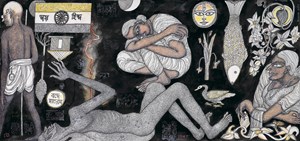
India's Independence Day, celebrated on August 15th, holds immense significance as it marks the country's liberation from British colonial rule in 1947. This day honours the sacrifices of countless freedom fighters and symbolises the triumph of unity, diversity, and self-determination.
When it comes to the discourse of Indian art, the theme of India’s independence has been a source of profound engagement for artists of different generations, who have consistently employed their art to commemorate the nation's historical journey towards liberation and to express the enduring spirit of freedom.
Whether it's the famed artists of Bengal School pre-1947 or the subsequent generation of PAG, Indian artists have frequently tackled the theme through their unique style and expressions. Reflecting a collective consciousness, their works serve as a reminder of India's enduring journey towards liberty.
As the 19th century drew to a close, India's political landscape underwent substantial changes, sparking a surge of nationalistic spirit across the nation. The rejection of British rule and its influence profoundly shaped the trajectory of modern Indian art. A pivotal turning point emerged with the establishment of Vishwa Bharti University. Leading this transformative shift were the Tagores, who championed a revival of Indian essence and artistic principles. Some of the greatest artists of the time, such as Nandlal Bose, Jamini Roy, Mukul Dey, Ramkinkar Baij, Benode Behari Mukherjee, and K.G. Subramanyan, among others, was trained at Santiniketan.

M. F. Husain, Untitled, Courtesy AstraGuru
One of the most famous works to signify the spirit of nationalism is a painting titled ‘Bharat Mata’ by Bengal School artist Abanindranath Tagore. In his portrayal, Bhārat Mātā appears as a four-armed Hindu goddess adorned in saffron attire. She clutches the Vedas, bundles of rice, a prayer garland (mala), and a pure white cloth. This image of Bharat Mata emerged as a poignant icon, carefully painted to evoke nationalist sentiments within Indians throughout the struggle for independence.
Renowned as a nationalist-revivalist and advocate of 'Swadeshi', values in Indian art, Abanindranath Tagore founded the illustrious 'Bengal School of Art,' a pivotal milestone in the advancement of modern Indian artistic expression. To counter Western modernism, he spearheaded the modernization of traditional Indian court styles like Mughal miniatures and Rajput artistry. His synthesised creations held such potency that British institutions eventually incorporated an Indian national style into their curriculum.
Nandalal Bose was another revered artist who was an important figure to champion the incorporation of indigenous sensibility in Indian art during the pre-independence era.

Untitled, Nandalal Bose, 1941, Courtesy AstraGuru
At the dawn of the 20th century, India resounded with fervent aspirations for liberation from British subjugation. By the 1930s, the fervour for Indian independence had reached its zenith. The emerging generation of artists, born during these tumultuous years, matured with a spirit of rebellion that profoundly shaped their artistic endeavours. Influenced by the global currents of art and diverse European movements, these youthful creators rejected the constraints imposed by their traditionalist forebears. Eager to forge their distinct artistic identities, they embarked on a journey to liberate their expression from conventional norms. At the same time, they rooted several of their works in the idea of Independent India, expressing them through their distinctive visual lexicon.

Ekta Bandhan, S. H. Raza, Courtesy AstraGuru
Renowned artist S.H. Raza's choice to employ primary colours in his works was deeply rooted in his reverence for the rich and chromatic cultural milieu. The varied and colourful landscapes of India, with their myriad traditions, customs, and celebrations, became a wellspring of inspiration. Raza's adeptfusion of reds, blues, and yellows was a visual homage to this multifaceted tapestry. Each stroke on his canvas seemed to resonate with the harmonious cacophony of festivals, rituals, and daily life, infusing his art with an intrinsic vitality that echoed the kaleidoscopic essence of India's cultural diversity.
On the other hand, M.F. Husain's Raj Series, created during the 1980s, encapsulates his exploration of India's colonial past and the Raj era's influence on its identity. Through a distinctive blend of abstraction and figurative representation, Husain dissected historical narratives, power dynamics, and societal transformation. The Raj Series serves as a thought-provoking mirror to India's historical consciousness, portraying colonial opulence, societal complexities, and the interplay between tradition and modernity. Husain's masterful strokes evoke a nuanced dialogue on heritage, politics, and the evolution of a nation grappling with its historical roots.
Visual artists across India have also captured Mahatma Gandhi's essence in multifaceted ways through their works. They depict his asceticism, humility, and unwavering commitment to nonviolence. Portraits, sculptures, and mixed-media creations reveal his iconic round spectacles, austere attire, and serene countenance.

Jagannath Mohapatra, Untitled, Courtsey AstraGuru
Contemporary Indian artists, including Atul Dodiya, Jagannath Mohapatra, and others have also delved into the nation's intricate sociopolitical fabric through their works, offering compelling insights into societal nuances. Their canvases, sculptures, and installations serve as mirrors reflecting the nation's diverse cultural, economic, and ideological landscapes. These artists engage with pressing issues such as identity, inequality, environmental concerns, and urbanisation. Through their art, these creators navigate the complex interplay between tradition and progress, amplifying voices that illuminate the challenges, aspirations, and transformations shaping India's dynamic society.
Image on top : Bharat Mata [Mother India], Abanindranath Tagore, Watercolour, 1905, Courtesy: Victoria Memorial Hall, Kolkata
Authored by Sneha Gautam, Senior Vice President at AstaGuru Auction House

ArtDependence Magazine is an international magazine covering all spheres of contemporary art, as well as modern and classical art.
ArtDependence features the latest art news, highlighting interviews with today’s most influential artists, galleries, curators, collectors, fair directors and individuals at the axis of the arts.
The magazine also covers series of articles and reviews on critical art events, new publications and other foremost happenings in the art world.
If you would like to submit events or editorial content to ArtDependence Magazine, please feel free to reach the magazine via the contact page.